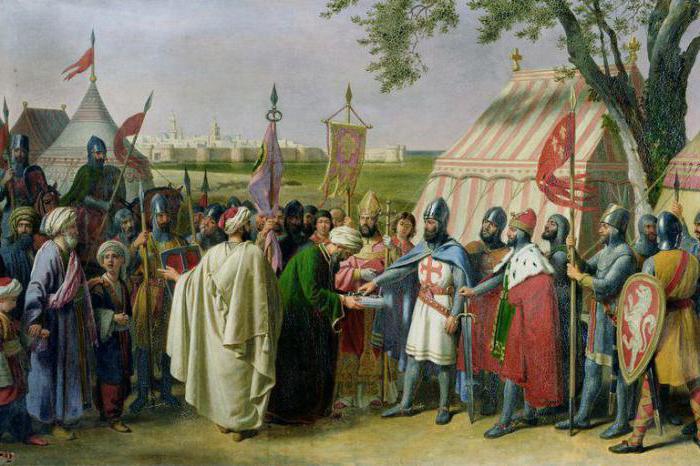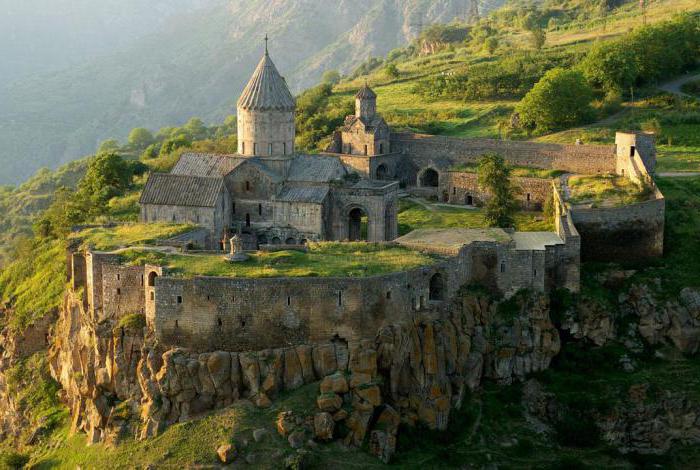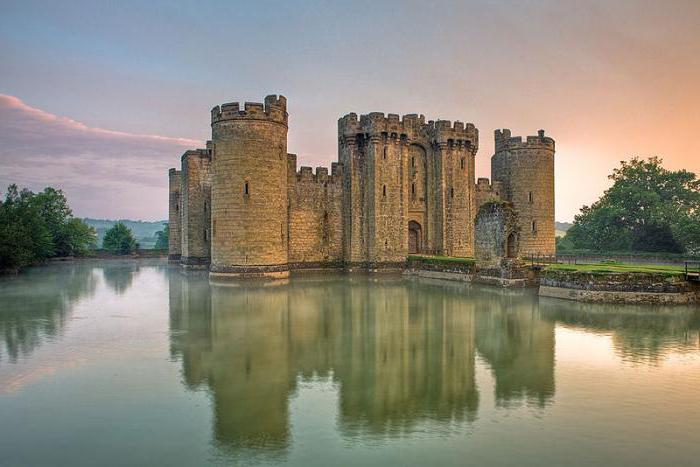Periodization - the subdivision of the past into periods of time (historical periods, centuries, epochs, etc.) - is one of the difficult problems of historical writing. The need for such a division for the ordering and analysis of historical events is not questioned by researchers. However, the practice of constructing periodization is often controversial. Historians pay attention to a significant proportion of the conventionality of isolating integral fragments of the past.
The Kingdom of Poland and the Grand Duchy of Lithuania unite against a common enemy - the Teutonic Order. Warsaw is just a small town in Mazovia. Trade is mainly concentrated in Free city Gdansk, with rye grain being the main export commodity and cattle and fur accounting for 30% of exports. This is the apogee of the power of the Polish-Lithuanian Commonwealth. The turning point in the war is the heroic defense of Czestochowa, which was supposedly saved thanks to the intervention of the Mother of God.
Madonna of Czestochowa was crowned queen and patron saint of Poland. The fight against the invaders has no effect, Warsaw and Krakow are linked to Russia and Austria, respectively. Poles support Napoleon's actions, hoping for his favor for the independence of the Polish state.
Widespread in the historical knowledge of the XIX century. the idea of objectivity of time as the environment in which events exist, in the XX century. gave way to ideas about the relativity of time. Historical time is thought of as a complex structure, to a large extent "established" by events or groups of events of the past. The very possibility of periodization is based on a rather conventional vision of history as continuous and unified. Proceeding from the idea of the generality of the process of human development, it is possible to single out any stages in it, to compare one era with another.
Jozef Piłsudski becomes head of state. State borders are still unstable, there is a struggle for disputed areas with Ukraine, Germany, Lithuania and Czechoslovakia. Poland was created as a republic. A multi-scale treasury reform is under way, mining continues in Silesia, and the first Polish port in Gdynia is being built. This is a consequence of the Ribbentrop-Molotov Pact concluded on August 23 between Nazi Germany and The Soviet Union... As a result, many people go to concentration camps in Treblinka and Ovicim.
For the study of history, it is important not only to date, to correlate what happened with a certain moment in time, but also to outline the boundaries of the periods when the typical similarity of historical phenomena was manifested among themselves.
Based on this similarity, historical periods can be distinguished, for example, the Renaissance or the Age of Enlightenment, etc.
Its main goal is to free capital from the Germans and gain sovereignty. The émigré government is returning from London, but Poland is under Soviet rule. His pontificate is guided by the idea of the closeness of the church and man, the protection of the conceived life and the dignity of the human person. This organization is rapidly gaining followers. The police curfew is ordered, the rights of citizens are limited, the military controls all forms of activity of citizens. The Communist Party allows free elections that defeat candidates for the solidarity bloc.
In cultures, mythology and religion of the past, there were different ways of periodizing history, for example, dividing the past by analogy with the seasons of the year, with the ages of a person. Greek poet Hesiod in the 7th century. BC NS. wrote about four past centuries - gold, silver, bronze and iron. Periodization in accordance with generations, political reigns, dynasties belongs to the most ancient ways of ordering history.
Only representatives of the Citizens' Committee sit in the government. Tadeusz Mazowiecki becomes Poland's first non-communist prime minister. A year later, Lech Walsha wins the presidential elections. The future of Poland in European structures is difficult to assess today. Despite numerous suggestions and suggestions, it does not disappear from function. At the funeral of the Holy Father in Plaka. Petra is attended by about 300,000 faithful and 200 presidents and prime ministers, as well as representatives of all world religions, including Islamic and Jewish clerics.
In the Middle Ages in the West, in the writings of the Church Fathers, two large systems periodization of world history. One linked the past and present of humanity with the four monarchies. According to this system, developed in the 4th century. Eusebius of Caesarea and Jerome of Stridon on the basis of the Old Testament "Book of the Prophet Daniel", four empires have changed in human history. The Roman Empire was viewed as the last state on earth, after which the end of history would come. The successive change of monarchies reflected the Divine plan, according to which people went to political and religious unity. In the XI-XII centuries. German historians substantiated the theory of “the transfer of the monarchy, which became widespread in the medieval West. According to this concept, after the death of the Roman Empire. God transferred the power of the Roman emperors, first to Charlemagne (and the State of the Franks), and then to the German Empire.
Later, the court found this decision illegal. Vilnius authorities refused to issue permission for marches to Gediminas Avenue. The results of regular elections in Zarasai-Visaginas and Birzai-Kupiskis districts were previously canceled due to serious violations that were committed, and in Ukmerge, a new member of the Seimas was elected instead of the deceased Julius Veselka. Presidential candidate Dalia Grybauskaite presented her candidacy to the Diet. In the second round of elections, he broke into the MEP, the former head of state Vytautas Landsbergis.
Lithuanian President Dalia Grybauskaite met with him, which caused outrage. Law enforcement agencies have initiated an investigation into the disclosure of classified information. She participated in the opposition rally, but the scheduled meeting with the Speaker of the Verkhovna Rada Volodymyr Rybak did not take place.
Most medieval historians preferred the six-age periodization of history as described by Aurelius Augustine. The centuries that have passed since the creation of the world were likened to the ages of man and the days of Creation. The sixth and last age - the old age of mankind - began from the time of the birth of Christ. For the early chroniclers, each day of Creation corresponded to a thousand years in history; the sixth century was to end with the end of the world and the "seventh day of the eternal Sabbath," the day of the resurrection from the dead. On this basis, the end of the world was expected in Europe in 1000; after that date historians had to adjust the calculations of the duration of each age of the world.
The concept of a historical era, which is used at the present time, arose relatively recently. It was affirmed in the context of the culture of the Renaissance and the Reformation, at a time when the influence of Christian eschatology and expectations of the imminent end of the world began to weaken in society.
Humanists proposed such a vision of history, according to which the most important milestone separating ancient history from the new, was considered the establishment of Christianity and the fall of the Western Roman Empire. The definition of "Middle Ages" entered historiography gradually, as the consciousness of the present moved away from the recent past. In European science, the idea of the Middle Ages was established after at the end of the 17th century. Professor of the German University H. Keller called one of the three books of his textbook "History of the Middle Ages", dividing history into "ancient" - before Constantine the Great, "medieval" - up to 1453, the date of the conquest of Constantinople, the center of Christendom by the Turks, and " new ”, which came after this date.
The division of history into large epochs contributed to the formation of historical consciousness in a society in which the process of secularization took place, made it possible to distinguish between the past, present and future as qualitatively different periods, and at the same time linked the historical process together. The division of world history into antiquity, the Middle Ages and modern times became dominant in the works of historians of the Enlightenment (18th century). Subsequently, this method of periodization, with certain amendments, was consolidated in the professional historiography of the 19th – 20th centuries.
This subdivision scheme is rather arbitrary. There are disputes about the boundaries of each era, so that the boundaries of antiquity, the Middle Ages and modern times fluctuate within two or three centuries. In addition, the basis of such a periodization of world history is the history of Europe, the events of which cannot serve as reference points for describing the past of China or India.
From the middle of the XIX century. various economic theories gained popularity, in accordance with which the periodization of world history was carried out. In the XX century. In the Marxist literature, the scheme of five socio-economic formations (primitive communal, slave-owning, feudal, capitalist, communist), dating back to the works of K. Marx and F. Engels, was established. After World War II, the theories of industrialization and modernization proposed in the areas of social and economic history were extended to the historical process as a whole. The World History was seen as a change different types society - pre-industrial (agricultural, traditional), industrial (modernized), post-industrial (informational). In the works of modern historians and social philosophers, much attention is paid to the study of the post-industrial stage of history.
In the XVII century. periodization by centuries originates. This way of dividing time assumes that each century has an inner unity, its own identity.
When one of the characteristics of the era is transferred to the essence of the whole period, generalizations arise ("the age of the Baroque" or "the age of Liberalism"), which are used as metaphors. But they require a certain caution, since they imply that, for example, the whole way of life in the 17th century. characterized by features of the Baroque style. Theories of global eras can also be viewed critically, since they are built on the premise that history - a kind of world whole - is comprehended in relation to what a person learns from his own experience.
Thus, eras and periods are the fruit of the work of historians. These constructs help in the study of the phenomena of the past; they should not be taken literally. As J. Collingwood wrote, everyone has to read about good or bad periods in history, but this or that assessment speaks more about how historians study the past than about the past that they study.
What does the history of the Middle Ages study? To form an idea of the essence of the issue, it is necessary to familiarize oneself with the subject of its study, the periodization of the main events that occurred in this segment of human history, and various points of view for the period under consideration.
The term "Middle Ages"
This term (or more precisely, “ Middle age") Originated in Italy. Humanists invented it at the end XV-early XVI cc. ad. Historians of the 17th-18th centuries have finally consolidated and divided the history of mankind into ancient, middle and modern times. In their deep conviction, and with their submission, the opinion began to wander, which is sometimes supported by some modern scientists that this was an era of cultural and spiritual decline, obscurantism, and humanity took a step back. Whether this statement is true, we will consider later in the article.
Now it is necessary to highlight the question of why the scientists of modern times introduced this term. Everything is very simple here. They extolled Antiquity to the skies - the era, in their opinion, the flourishing of science, art and culture. Then the Great Roman Empire collapsed, and Europe plunged into chaos for centuries.
Wars, epidemics, religious intolerance and bigotry have negatively affected humanity. But then the era of the New Age began, and then the successive eras of the Renaissance and the Enlightenment gave mankind new hope for the reign of reasonable, humane and justified laws.

On the question of periodization
The time frame of the Middle Ages by historians different countries are treated in different ways. And this is not surprising, since in different corners the globe had its own characteristics and specificity. However, the beginning of the Middle Ages does not cause controversy and disagreement.
It is believed that this era entered into its legal rights with the collapse of the Roman Empire and this happened on September 4, 476. The Senate of Rome, under pressure, announced that the Western Empire no longer needed an emperor and the diadem and scepter left for Constantinople. Symbols of the imperial power and greatness of Rome.
When it came to where to end this significant period in the history of mankind, then opinions were divided. Each side offered its own version and gave a well-grounded argumentation. This is the capture of Constantinople (1455), and the beginning of the Reformation (1517) and many other equally significant and unique events.
Unfortunately, history is used as one of the most important instruments of ideological influence. At the same time, its most important and main task is forgotten - the study and analysis of the experience of mankind in order to prevent offensive and terrible mistakes. Therefore, the differences in chronology, and most importantly, the fact that the term "Middle Ages" is practically inapplicable to the history of all peoples of the world, have consolidated its convention.

Periodization
However, despite the conventionality of periodization, it is still necessary to distinguish three main periods, which are adhered to in Russian historiography and in most Western states:
Early middle ages
High, developed, or classical Middle Ages
This is the middle of the XI century - the time of the emergence of medieval cities and the beginning of the Crusades, and this period of history ends with the era of developed European trade, the flourishing of crafts and art.
Late Middle Ages, or Early Modern Times
End of the XIV-XVI centuries. - the heyday of the era of great geographical discoveries.
A small disclaimer needs to be made. In the West, there is a different time frame for the Middle Ages. It ends happily after the famous discovery of America by Christopher Columbus in 1492.

Middle Ages: subject of study
What does history study and what is the subject of its study? These are the features, patterns and conditions for the development of society of that period. First of all, this is the origin, formation and development of feudal relations. It was they who became the main factor that influenced social relations in society and its cultural development. Thanks to feudal relations, political map that time. National cultures and characters known in modern times arose.
Source classification
Answering the question "what the history of the Middle Ages studies", it will be appropriate to characterize and give a classification of the sources that are used in the study of this issue. These are five types of sources that differ in the way they record information. Let's list these sources:
- Natural and geographical (thanks to its study, you can get all the necessary data on environment: climate, soil, landscape, etc. This is necessary for understanding the natural specifics of the region under study.).
- Ethnographic (folklore, customs, traditions, national costumes, dwellings, etc. are studied).
- material (this includes objects of material culture. These are weapons, utensils, jewelry, etc. Everything that in the form of material objects has come down to our days from the past.).
- Artistic - visual (paintings, architectural monuments, various sculptures, mosaics, etc.).
- Written (these are texts, and it does not matter what they are written in - notes, letters, hieroglyphs, cuneiform or numbers.).

Classes of written sources for the study of the history of the Middle Ages
Written sources, in turn, are divided into classes for convenience. It is necessary to briefly describe each of them. This is how they look:
- Narrative, or narrative (tell about events in an arbitrary form, sometimes using fiction).
- Documentary (such a class of a source in a formalized language illuminates narrow and individual moments in the socio-economic, legal or political spheres).
- Legislative (this class of source raises questions about the history of the Middle Ages purely in the legal field. But here one interesting feature- they very often reflect not only legislative practice. According to them, it is very clearly possible to trace how the legislator is trying to change it, sometimes for a specific situation.).

Middle Ages in Russia
As already mentioned, the periodization of the Middle Ages is a convention, therefore, understanding this phenomenon creates the conditions when it is necessary to take into account historical specifics region. It is no coincidence that medieval Russia is considered by historians as a territory where feudal relations arose more slowly, based on the data available modern science... Therefore, here the periodization looks like this:
- IX-XII centuries - Kievan Rus, led by Kiev - "the mother of Russian cities."
- XII-XIII centuries - the era of civil strife between individual principalities and the beginning of the establishment Tatar-Mongol yoke in some Russian lands.
- XIV-XVII centuries - the unification of the Russian lands under the rule of Moscow.
Why medieval Russia carried out construction much later than its European neighbors is a topic of additional research. And the final point on this issue has not yet been put.
Feudalism
The nascent feudalism and the establishment of the universal power of the Church entered into a clear antagonism with the ancient slave system existing at that time, but gradually dying away. There was a change in the new socio-economic formation. Which resulted in a huge surge of violence and cruelty.
This was expressed not only in the collapse of the Western Roman Empire, new players appeared on its ruins in the form of barbarian kingdoms. And the Great Migration of Peoples, which lasted from the 4th to the 7th centuries, added confusion. The changes took place, first of all, in the very environment of the barbarian tribes.
The emergence of barbarian kingdoms, the strengthening of the power of their kings inevitably led to stratification within their society. Feudal relations were the instrument that strengthened the power of the "suzerain". For this, the vassals received not only land, but also the people who cultivated them. Gradually, their descendants also received this status, with the right of further inheritance.

Strengthening the peasantry
It is necessary to briefly touch upon the main events in the history of mankind, which not only influenced the way of life of medieval society, but also created the preconditions for further development. A textbook on the history of the Middle Ages gives a brief chronology of those events that took place in more than a thousand years of history.
At the end of the 5th-beginning of the 6th centuries. (481-511) the tough and ambitious king Clovis is promoted among the Franks. He not only became the ancestor of the Merovingian dynasty. Under him, perhaps on his direct instructions, the "Salicheskaya Pravda" was issued. Thanks to her, it is possible to study and analyze the existing archaic orders. And the most important thing is the emerging property and social inequality. Clovis and his successors stubbornly conquered lands in what is now France.
But the dynasty changed and Charles I created huge empire however, it did not last long. But under him the landlessness and enslavement of the peasantry finally took shape.
The Christian religion has facilitated this process. The Church received huge allotments and riches and became so strong that it itself interfered in the affairs of European rulers and even sanctioned predatory Crusades under the guise of a specious pretext. Major events the Middle Ages include many episodes, one way or another, influencing the course of modern history.
Cities and commerce
If one studies the history of mankind dispassionately, then one can come to the conclusion that economic interests are the basis of any conflict. It is then that the necessary ideology is formed, which sometimes pushes entire nations to mutual extermination. Medieval wars, and modern wars as well, illustrate this perfectly. But it is also true that it is the economic benefit that is the necessary engine that not only changes society, but also propels it towards progress. Trade and economic ties inevitably lead to cultural and technical borrowing.
Cities formed on major trade routes and around fortified fortresses (burgs) became centers of trade, crafts, science and culture. Sometimes people went to other countries to learn and excel in their field or to bring exotic goods.
Finally
What does the history of the Middle Ages study? It is considered to be decline and decay. At first glance, one can partially agree with this. Medieval wars, unsanitary conditions, burning of people and other "delights" do not inspire optimism. However, it should be understood that this was a necessary path for humanity when changing the socio-economic formation. The history of formation has passed a long and thorny path, but history cannot be abandoned: no matter how bitter and terrible lessons it may give.




